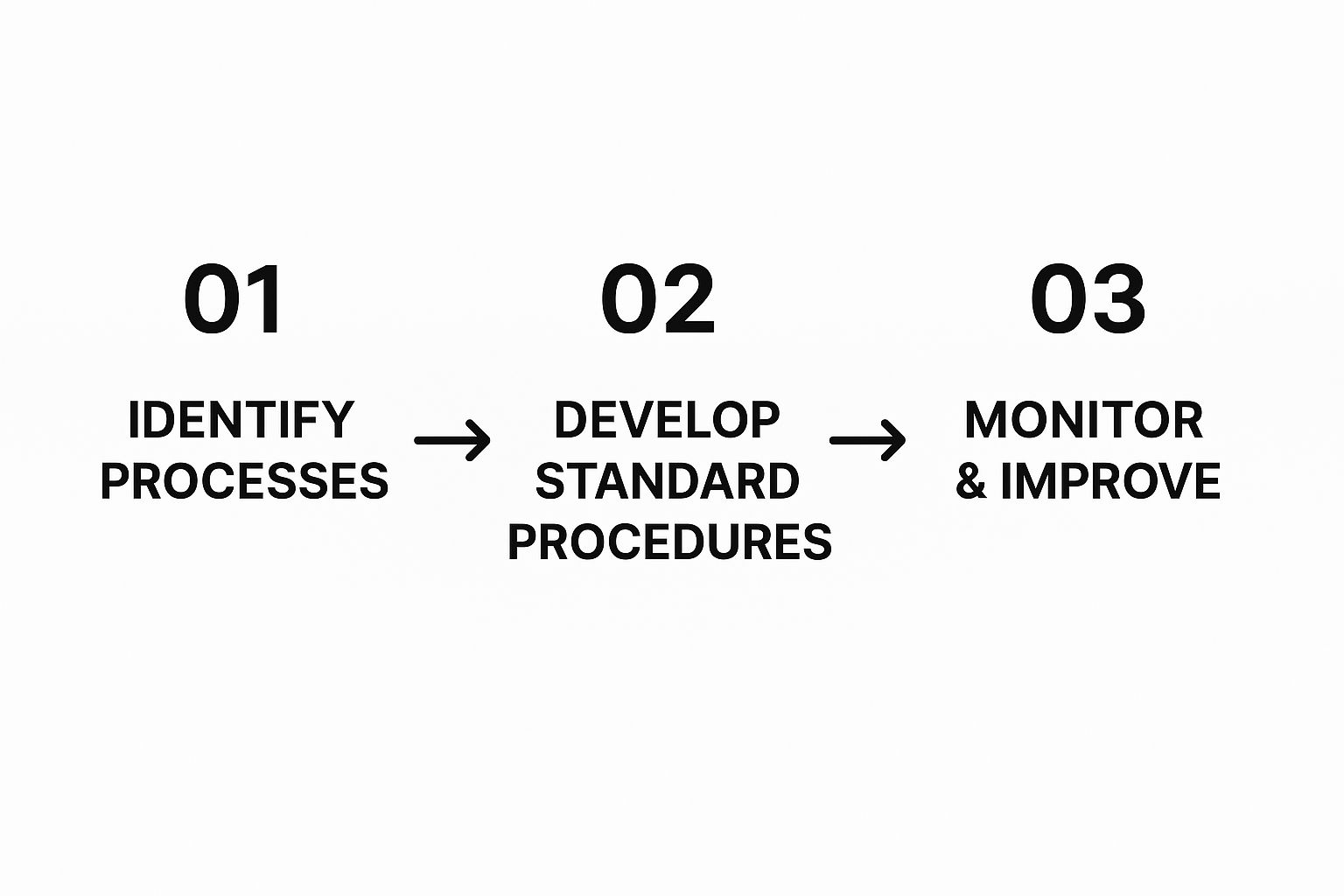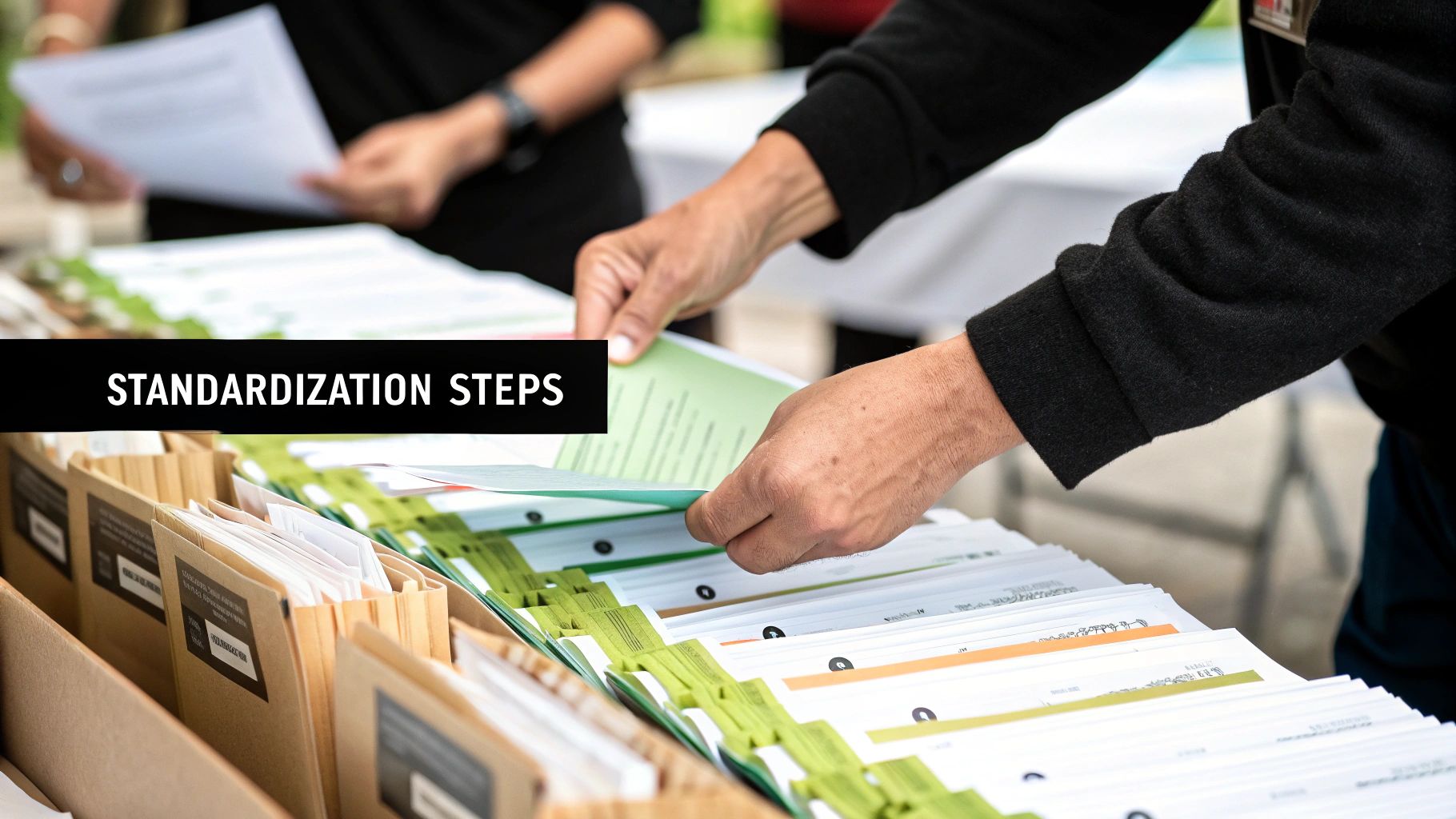Let’s talk about a concept that often gets a bad rap in creative circles: process standardization.
When you hear that phrase, you might picture rigid, soul-crushing rulebooks designed to stamp out originality. But that’s a huge misconception. In reality, it’s about creating a smart, documented framework for all those repetitive tasks that eat up your team's time and energy. It’s a way to get rid of the guesswork.
The whole point is to make your outcomes more predictable and reliable, freeing up your team to focus on what they do best: being creative.
More Than Just Rules: The Real Value of Standardization

I get it. "Standardization" sounds restrictive. But think of it this way: true process standardization isn't about boxing people in. It’s about building a stable foundation so your team can consistently do their best work. When you define the how for routine stuff, you free up a ton of mental space for the work that actually moves the needle—innovation, big-picture problem-solving, and genuine creative thinking.
This isn't some new-age business fad. The idea goes way back to Frederick Taylor's work in the late 19th century and was famously put into practice by Henry Ford's assembly line. They proved that standardizing work methods could lead to huge gains in efficiency and consistency.
Fast-forward to today, and the benefits are just as clear. Businesses that nail their processes often see up to a 20% cut in operational costs and can slash process cycle times by 50%. This stuff works.
Unlocking Efficiency and Consistent Quality
Take a look at your team's day-to-day. How many different ways do people tackle the exact same task? Every slight variation is a chance for an error to creep in, for quality to dip, or for time to be wasted. Standardization cuts through that noise by establishing one clear, best-practice approach.
The ripple effect is pretty powerful:
- Reduced Costs: Efficient tasks mean less wasted time, fewer do-overs, and fewer costly mistakes. Simple.
- Better Quality: A standard process ensures every single thing you produce hits the same high bar. That’s how you build customer trust.
- Faster Timelines: When everyone knows the game plan, projects just move faster. No more bottlenecks caused by confusion or uncertainty.
The goal isn’t to turn your team into robots. It’s to build a reliable system that supports their expertise. It’s about making sure excellence is something you can repeat, scale, and bake right into your company’s DNA.
Creating a Launchpad for Innovation
Here’s the biggest myth I want to bust: standardization kills creativity. It's actually the opposite.
When your team isn't constantly reinventing the wheel for basic administrative tasks, they have more brainpower left for the fun stuff. A solid process acts like a safety net, giving creatives the confidence to experiment and push boundaries within a structure that works.
Of course, you can't standardize what you don't understand. The first step is always to take a hard look at how you're doing things right now. A great place to start is with your brand's consistency, which often shines a light on messy internal processes. Our guide on how to do a brand audit can help you spot those hidden inconsistencies.
This initial deep dive gives you the baseline you need to start building standards that actually make a difference.
Auditing Your Current Workflows for Hidden Gaps
Before you can build a better, more efficient creative process, you have to get brutally honest about what’s happening right now. You can't standardize what you don't truly understand. This first step is all about a deep-dive audit to uncover the hidden gaps, bottlenecks, and messy inconsistencies that are quietly draining your time and budget.
Think of it as creating the "before" picture. It’s not about pointing fingers; it's about establishing a clear baseline so you can focus your process standardization efforts where they’ll actually make a difference. We need a shared understanding of reality, warts and all.
This initial audit is the critical first step in a much larger cycle of continuous improvement.

As you can see, identification is where it all begins. From there, we can build standards and refine them over time.
Mapping the Current State
Your first move is to map out your existing workflows as they actually happen—not how you think they happen. Don't rely on old documentation or assumptions. Grab a whiteboard or fire up a tool like Miro and chart every single step from start to finish.
Let's imagine you're auditing your client onboarding process. You’d get granular and map out every action:
- The moment a project is handed off from sales to the project manager.
- The very first email that goes out to the new client.
- The internal team kickoff meeting.
- The official client kickoff call.
- How, when, and by whom client assets are requested and collected.
Just by mapping this out, you might discover that three different people are sending "welcome" emails, creating confusion from day one. Or maybe you'll find there’s no clear owner for gathering client info, which explains why projects are always delayed right at the start. These are the exact insights you're hunting for.
Uncovering Bottlenecks and Inconsistencies
With a visual map in hand, the real investigation starts. The most valuable intel you'll get is from the people living these processes every single day. Sit down with your team, pull up the flowchart, and walk through it together.
Ask open-ended questions that invite candid feedback:
- "Where do projects always seem to get stuck?"
- "Which part of this whole process makes you want to pull your hair out?"
- "If you had a magic wand, what's the one thing you'd change about how this works?"
Their answers are pure gold. They’ll point out the unofficial workarounds they’ve invented to bypass a broken system or highlight where tasks are constantly dropped between teams.
A process audit isn’t just a technical exercise; it’s a human one. It builds trust and shows your team that their daily frustrations are being heard and will be addressed. This buy-in is essential for when you start rolling out new standards.
To help structure this conversation, a simple checklist can be incredibly effective. It ensures you’re asking consistent questions across different teams and projects.
Your Process Audit Checklist
Use this checklist to systematically evaluate your existing processes and identify key areas for standardization.
| Audit Area | Key Questions to Ask | Metrics to Collect |
|---|---|---|
| Communication | How are project updates shared? Who is responsible for client communication? Where do communication breakdowns most often occur? | Number of "urgent" emails, average response time, client feedback scores, number of meetings per project. |
| Handoffs | Are there clear transition points between teams or project phases? Is information consistently lost during handoffs? | Revision cycles, time spent clarifying tasks, percentage of projects with delayed handoffs. |
| Tools & Tech | Is everyone using the same software for the same tasks? Are there redundant tools? Are we paying for software that no one uses? | Software licenses vs. active users, time spent searching for files, number of different tools used per project. |
| Approvals | Who needs to approve what, and when? Is the approval chain clear? How long do approvals typically take? | Average approval time, number of stakeholders in an approval loop, percentage of approvals requiring follow-up. |
| Scope Management | How are changes to the project scope requested and approved? How often does scope creep happen? | Number of change orders per project, unplanned hours, impact on timelines and budget. |
This checklist gives you a tangible way to gather evidence and move beyond anecdotes.
Often, you'll find these small, nagging inconsistencies are just symptoms of a much bigger problem. When processes are vague and undefined, projects naturally expand without any guardrails. Learning how to get a handle on this is crucial, and you can dive deeper into strategies for managing project scope creep in our detailed guide. Establishing clear, audited workflows is your first and most powerful line of defense.
Designing Standards Your Team Will Actually Use

Okay, you've done the audit. Now comes the fun part—designing the new standards. This is where so many teams go wrong. They create some dense, formal manual that gets filed away in a digital drawer, never to be seen again.
Let's be real: your goal is to create documentation so clear and genuinely helpful that your team actually wants to use it.
So, what's the secret? Simple. Don’t build this stuff in a vacuum. The most successful process standardization I've ever seen comes from collaboration. You have to bring the people who live and breathe this work every day into the design process. They’re your real experts, and their insights are gold. They'll make sure the new standards solve actual problems, not just theoretical ones.
Plus, when people help build the solution, they’re bought in from day one. That makes the eventual rollout a thousand times smoother.
Crafting Clear and Simple Documentation
Your documentation needs to be a lifeline, not an encyclopedia. Think simple. Think clear. Different tasks call for different tools, so don't be afraid to mix it up.
Your toolkit could look something like this:
- Simple Checklists: Perfect for those repeatable, multi-step tasks. Think "publishing a blog post" or "setting up a new client folder."
- Visual Flowcharts: When things get complicated with lots of "if-then" scenarios—like a client feedback loop—a flowchart makes it all make sense at a glance.
- Video Walkthroughs: Honestly, for showing someone how to use a new piece of software or tackle a technical task, nothing beats a quick screen recording.
As you're designing these standards, it's a great time to build in some guardrails. A common tripwire for any creative team is scope creep. Strong documentation and clear client sign-offs are your best defense. You can even explore other strategies to prevent scope creep and bake them right into your new workflows.
Keeping Standards Current with Version Control
A standard is only useful if it’s the right one. Processes change. Tools get updated. Best practices evolve. This is where version control becomes absolutely essential.
Think of your process documentation as a living thing, not a stone tablet. You need a dead-simple way to make sure everyone is always using the latest version. It can be as basic as a naming convention like “Client Onboarding SOP v2.1” and assigning an owner to each document.
This isn't a new idea. After World War II, the International Organization for Standardization (ISO) was formed in 1947 to create this kind of consistency on a global scale. They coordinate with national bodies to create the uniform standards that make modern industry possible.
Adopting that same mindset—maintain, update, and own your standards—ensures they stay reliable. It makes your team's day-to-day work way more efficient and completely changes the game for onboarding new hires. They can get up to speed on the "right" way to do things from their very first day.
Rolling Out New Standards Without the Headaches
A brilliant new standard is completely useless if it just collects digital dust in a shared folder. Let's be honest, the real make-or-break moment for any process standardization effort is getting your team to actually use it. A clumsy rollout can create more chaos than it solves, breeding resentment and ensuring your new, improved processes are dead on arrival.
The secret isn’t some big, dramatic launch day. It’s a carefully managed, phased approach. You have to respect your team's existing habits while clearly showing them how the new way is better. Think of it less like dictating change and more like guiding your team toward a workflow that just makes more sense.
Start Small with a Pilot Program
Instead of dropping a dense, 50-page SOP manual on everyone's desk and hoping for the best, find a small, low-risk project to test it on. Or, even better, pick a single, enthusiastic team to be your guinea pigs. This pilot program becomes your real-world laboratory. It’s where you see how the new standard holds up under actual pressure, but without derailing the entire company if something goes wrong.
It's just like how a software company would never launch a major update without a beta test. You should treat your internal processes with that same level of care.
This test run will immediately expose friction points you never saw coming and give you direct, unfiltered feedback from the people who will live with these standards every day. This is your chance to fix the kinks when they’re small and manageable, before you go wide.
Plus, a controlled test creates champions. When the pilot team sees firsthand how the new standards are cutting down on errors or saving them precious time, they become your most powerful and authentic advocates for the change.
Master Your Communication Strategy
How you talk about the change is every bit as important as the change itself. People are naturally wired to resist things that feel forced on them. Your communication needs to hammer home the "why" behind the new standards, not just the "what."
Your goal here is to build genuine understanding and dial down the anxiety. Frame the changes around shared benefits everyone can get behind:
- For the designer: "This new checklist will eliminate all the guesswork in client handoffs. No more late-night emails hunting down missing files."
- For the project manager: "By standardizing our briefing template, we can finally stop the endless scope creep that kills our timelines and budgets."
- For the company: "This consistency helps us deliver the high-quality work our clients expect, every single time. That's how we grow."
Ambiguity is the enemy of adoption. You have to be crystal clear, empathetic, and willing to repeat the message across different channels—in team meetings, over email, and during one-on-one check-ins.
The most effective rollouts don't dictate; they empower. Your job is to show the team how process standardization removes roadblocks and ambiguity, ultimately making their work easier and more rewarding.
When you position standardization as a tool for support rather than a rule for compliance, the entire dynamic shifts. You move from resistance to collaboration. And that cooperative spirit is what will make your new processes stick for the long haul.
Working with a Global Team? Here’s How to Standardize Your Processes

Taking your creative operation across borders is exciting. But it also adds a fascinating—and complex—layer to how you get things done. What’s a perfectly smooth workflow in your Berlin office might completely fall flat with your team in Tokyo.
The real challenge isn't just about translating documents. You're suddenly navigating a maze of different cultural norms, local laws, and unique market expectations.
Let’s be real: forcing a one-size-fits-all model on a global team is a recipe for disaster. It completely ignores the local expertise that makes your regional teams so valuable in the first place. The goal is to strike a smart balance—finding what must be consistent across the board and what should be flexible enough to adapt.
Figuring Out Your Global Core vs. Local Flex
I find it helpful to think about processes in two distinct buckets: the non-negotiables and the adaptable.
Certain functions are the operational backbone of your company. They demand a globally unified approach to keep everything running cohesively. On the other hand, many of the customer-facing and market-specific activities thrive when they have local flavor. Empowering your regional teams here shows you trust their insights, and frankly, it just gets better results.
Here’s a simple way to break it down:
-
Global Core (Keep it Standard):
- Financial Reporting: This is essential. You need a single, unified view of the company’s financial health. No wiggle room here.
- Brand Identity: Your core brand guidelines have to be consistent everywhere. It’s how you build a strong, recognizable presence worldwide.
- Cybersecurity Protocols: Security is universal. You can’t leave critical safety measures up to regional interpretation.
- Core Product/Service: The fundamental value you offer customers should be the same, no matter where they are.
-
Local Flex (Let Teams Adapt):
- Customer Service Scripts: The way you talk to customers should absolutely reflect local communication styles and etiquette.
- Marketing Campaigns: A campaign that kills it in North America could easily miss the mark in Southeast Asia. Let the locals lead.
- Hiring Practices: This is a big one. You have to comply with local labor laws and cultural norms when hiring.
- Sales Tactics: Negotiation styles and how you build relationships can vary dramatically from one culture to another.
Navigating the Nuances: Culture and Company Structure
Here’s something I’ve seen time and again: success in global process standardization often comes down to management strategy, not just geography.
Research on global ERP rollouts has shown that over 50% of processes can differ wildly between locations, creating massive headaches when trying to harmonize everything. What the studies found was that a strong international management team that enforces structural conformity often does much better than one that is just geographically close.
The key takeaway is this: you need a system that respects institutional diversity while maintaining a strong, integrated core. This requires a sophisticated approach to creative project management, one that is both structured and adaptable.
When you create this dual framework, you’re building a much more resilient global operation. You get all the efficiency that comes with standardization, but you don't lose the local intelligence that gives you a competitive edge in each market. That balance? It's the hallmark of a truly effective global strategy.
Got Questions About Standardizing Your Process?
Of course, you do. Even the most bulletproof plan will run into questions and a few hurdles. It's just a natural part of making a big change. I’ve seen that leaders often wrestle with the same concerns, from getting the team on board to actually proving the whole effort was worth it in the end.
Let’s get into those common questions. Tackling them head-on will make the rollout smoother and ensure your new standards actually make a difference.
The biggest roadblocks are rarely technical; they’re human. Getting buy-in from leadership and helping your team navigate the change are almost always the toughest parts.
For leadership, you need to frame this as a strategic move, not just another line item on the budget. Show them the data you pulled from your audit—the hours leaking away, the endless revision cycles, the projects creeping over budget. Make the cost of doing nothing painfully obvious.
As for your team, any pushback usually comes from a fear of losing creative freedom. They worry that "standards" just means "boring rules." This is why you have to involve them in creating the process. When they help build the standards, they see them for what they are: tools to eliminate grunt work, not cages to stifle their talent.
How Do You Actually Measure the Impact?
You can’t improve what you don’t measure. It’s an old saying, but it’s true. To prove this was a smart move and keep the momentum going, you need to track the right Key Performance Indicators (KPIs). The metrics you pick should directly connect back to the problems you were trying to solve in the first place.
Here are a few of the most powerful KPIs I’ve seen work wonders:
- Error Rate Reduction: Simply track the number of mistakes or defects before and after you roll out the new process. Seeing a 15% reduction in errors is a huge, undeniable win.
- Cycle Time Improvement: How long does it take to get a project from "kickoff" to "done"? Shaving days—or even hours—off your timelines is a crystal-clear sign of success.
- Cost Savings: Add up the savings from less waste, fewer do-overs, and reduced overtime. This draws a straight line from your new standards to the company's bottom line.
- Team and Client Satisfaction: Use quick, simple surveys to see how these changes are impacting morale and the client experience. Better processes almost always lead to happier people, and you can learn more about how to increase client satisfaction through consistent, reliable delivery.
Avoiding Soul-Crushing Bureaucracy
This is the big one, isn't it? How do you create standards without building a rigid, bureaucratic machine that kills all innovation?
It all comes down to knowing what to standardize and what to leave to the pros.
The goal of process standardization is to create a strong framework, not a cage. Standardize the predictable, repeatable tasks to free up mental energy for complex, creative problem-solving.
For instance, your client intake process? Standardize it. Your file naming conventions? Absolutely standardize those. Your project handoff checklists? You bet. These are the routine things where consistency saves everyone from chaos.
But you should never try to standardize a brainstorming session or tell a designer exactly what artistic approach to take. That's where their expertise shines.
The best systems create clear guardrails but leave plenty of room to play inside them. It's about giving your experts a solid foundation to stand on, so they have the confidence to do their absolute best work.
Ready to build a high-performing creative team? Creativize is the platform that connects you with top-tier local talent who understand the importance of efficient, quality-driven processes. Find the professionals you need to scale your business today.

